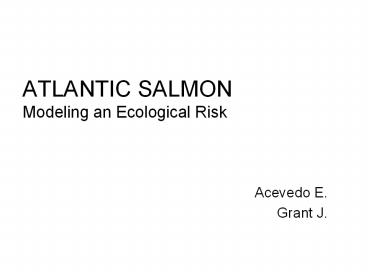ATLANTIC SALMON Modeling an Ecological Risk - PowerPoint PPT Presentation
1 / 23
Title: ATLANTIC SALMON Modeling an Ecological Risk
1
ATLANTIC SALMONModeling an Ecological Risk
- Acevedo E.
- Grant J.
2
- Introduction
- Models
- Remarks
- Acknowledgments
- Reference
3
- Introduction
- Models
- Remarks
- Acknowledgments
- Reference
4
Introduction
- Culture atlantic salmon is a million USD industry
that exceeds wild salmon catch by 70 (Naylor et
al. 2005).
- From 1989-2000 1.4 million salmon escaped from
the farms, because of Hardware failures,
fish-transfer and handling mishaps and
boat-operation problem (Kelso, 1999).
- Genetically engineered salmon have growth and
reproductive advantages over the wild types (Muir
and Howard, 2004).
Source FAO, 2007
5
- Introduction
- Models
- Remarks
- Acknowledgments
- Reference
6
Model assumptions
- Rate of escaped salmons is 1 of annual
production (Kelso, 1999). - Introduced species have double the growth rate of
the wild type (Coghlan et al. 2007). - Evaluating an independent gene.
- No sexual selection associated with the
segregation of the genes. - Population are large and the interactions are
continuous.
7
F
ß
I
H
W
Farm
8
A A
A AA AA
A AA AA
A A
A AA AA
a Aa Aa
F
ß
A a
A AA Aa
a Aa aa
I
H
W
Introduced
9
a a
a aa aa
a aa aa
a a
A Aa Aa
a aa aa
F
ß
A a
A AA Aa
a Aa aa
I
H
W
Wild
10
A a
A AA Aa
a Aa aa
A a
A AA Aa
A AA Aa
F
ß
A a
a Aa aa
a Aa aa
a a
A Aa Aa
A Aa Aa
I
H
W
Hybrid
11
Model 1
- Pros
- Terms have good biological meaning
- Cons
- No nontrivial fixed points
- Difficult to analyse numerically or analytically
12
Model 2
- Pros
- Includes competition terms
- Nontrivial fixed points
- Cons
- Negative hybrid population values
13
Model 3
- Pros
- No negative hybrid population values
- Interesting dynamics between wild and the
introduce - Cons
- No hybrid population appear
- Spontaneous generation
14
Model 4
- Pros
- Interesting relationship between competition
terms and genetic proportions - Cons
- Wild population always collapses
- Negative values for hybrid population
15
Model 5
16
Model 5 (Finally) Works!
- Pros
- Solved most of the problems
- Integrate birth and death in terms of the genetic
proportions - Gave realistic results
- Nice mathematical form
- Cons
- Unbounded values for some parameter choices
- Only depends on time (not spatial)
17
Fixed Points and Stability
- Fixed points
- (ß0.01,µ0.01,?49)
- (w,h,i) (0,0,9800)
- Stability
- Point is stable since all the eigenvalues are
negative
18
- Introduction
- Models
- Remarks
- Acknowledgments
- Reference
19
Remarks
- Proving these hypothesis in the wild environment
could cause irreversible harm - Mathematical modelling is a helpful tool to solve
this problem - Model five is a good start but it needs
improvement and validation
20
- Introduction
- Models
- Remarks
- Acknowledgments
- Reference
21
Acknowledgments
Dr. Thomas Hillen, Dr. Petro Babak , Dr. Jim
Keener and Dr. Tomas de Camino Beck for their
advice and NIMO and his NUCLEUS for his motivation
Thanks!
22
- Introduction
- Models
- Remarks
- Acknowledgments
- Reference
23
References
- Coghlan, S., M. Connerton, N. Ringler, D.
Stewart, J. Mead. 2007. Survival and growth
responses of juvenil salmonines stocked in the
eastern lake Ontario tributaries. Transactions of
the American Fisheries Society 136 56-71. - FAO Food and Agriculture Organization of the
United Nation. 2007. FishStat-Fishery
information, data and statistics unit online
lthttp//www.fao.org/fi/default.aspgt. Consulted
May 9, 2007. - Kelso, D. 1999. Genetically engineered salmon,
ecological risk, and environmental policy.
Bulletin of Marine Science 74(3) 509-528. - Naylor, R., K. Hindar, I. Fleming, R. Goldburg,
S. Williams, J. Volpe, F. Whoriskey, J. Eagle, D.
Kelso and M. Mangel. 2005. Fugitive Salmon
Assessing the risk of escaped fish from net-pen
aquaculture. BioScience 55(5) 427-437. - Muir, W. and R. Howard. 2004. Characterization of
environmental risk of genetically engineered
organisms and their potential to control exotic
invasive species. Aquatic Science 66414-420.































